Report on Evolutionary Theories, Animal Life Cycles, and Survival
VerifiedAdded on 2020/10/22
|11
|3388
|461
Report
AI Summary
This report provides a comprehensive overview of evolutionary theories within animal science, exploring organism life cycles and survival strategies in a changing environment. It delves into animal mitotic processes, cell division, and replication processes, highlighting similarities and differences. The report also examines homoeostatic mechanisms unique to animal species, along with major grades of organization related to architectural patterns and their connection to sentience and survival. Furthermore, it discusses the principles of modern evolutionary theory, its implications, and the influence of environmental changes on phenotype and inheritance patterns. Key topics include natural selection, genetic drift, gene flow, and various mechanisms for maintaining internal body conditions. The report covers various animal species, their adaptations, and the importance of understanding these concepts for environmental science.
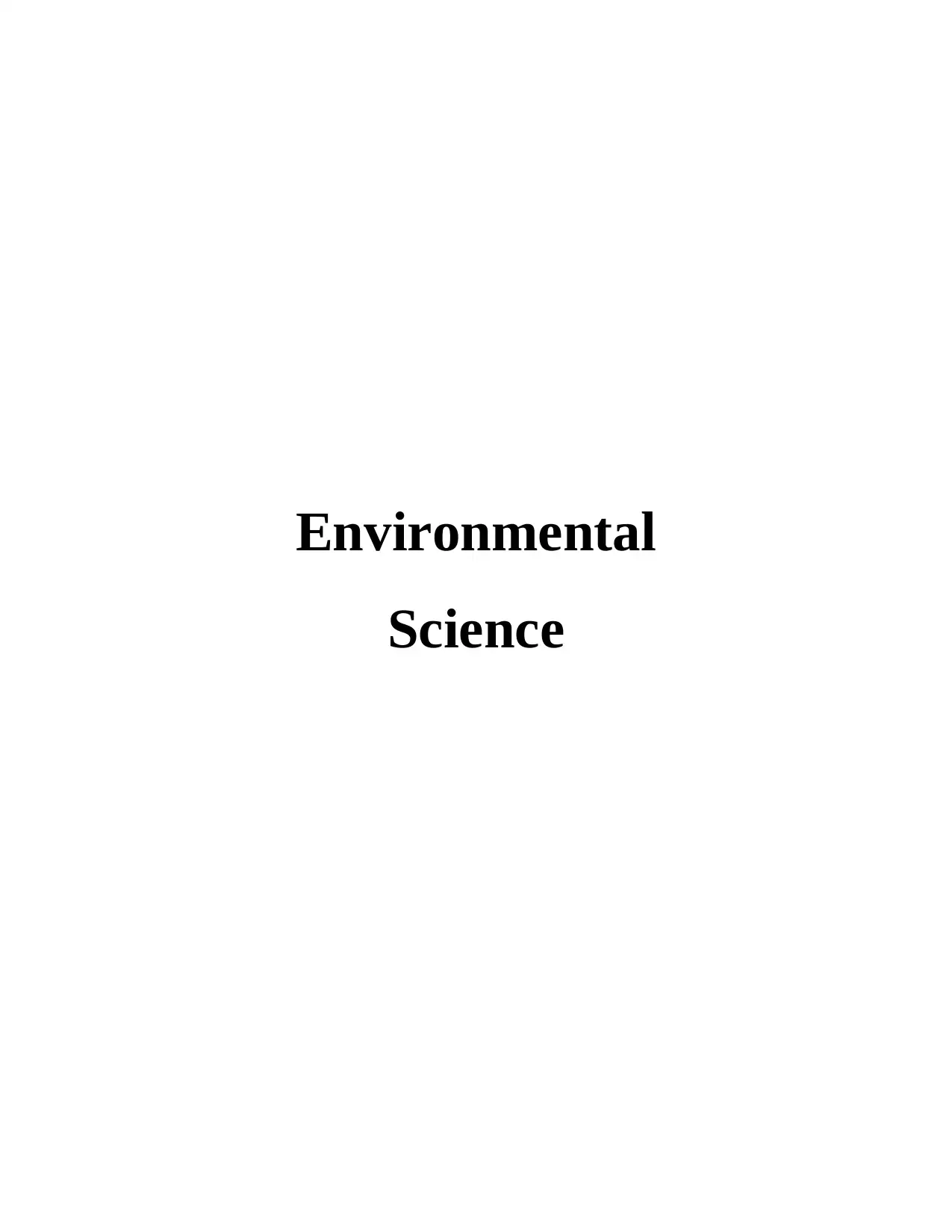
Environmental
Science
Science
Paraphrase This Document
Need a fresh take? Get an instant paraphrase of this document with our AI Paraphraser
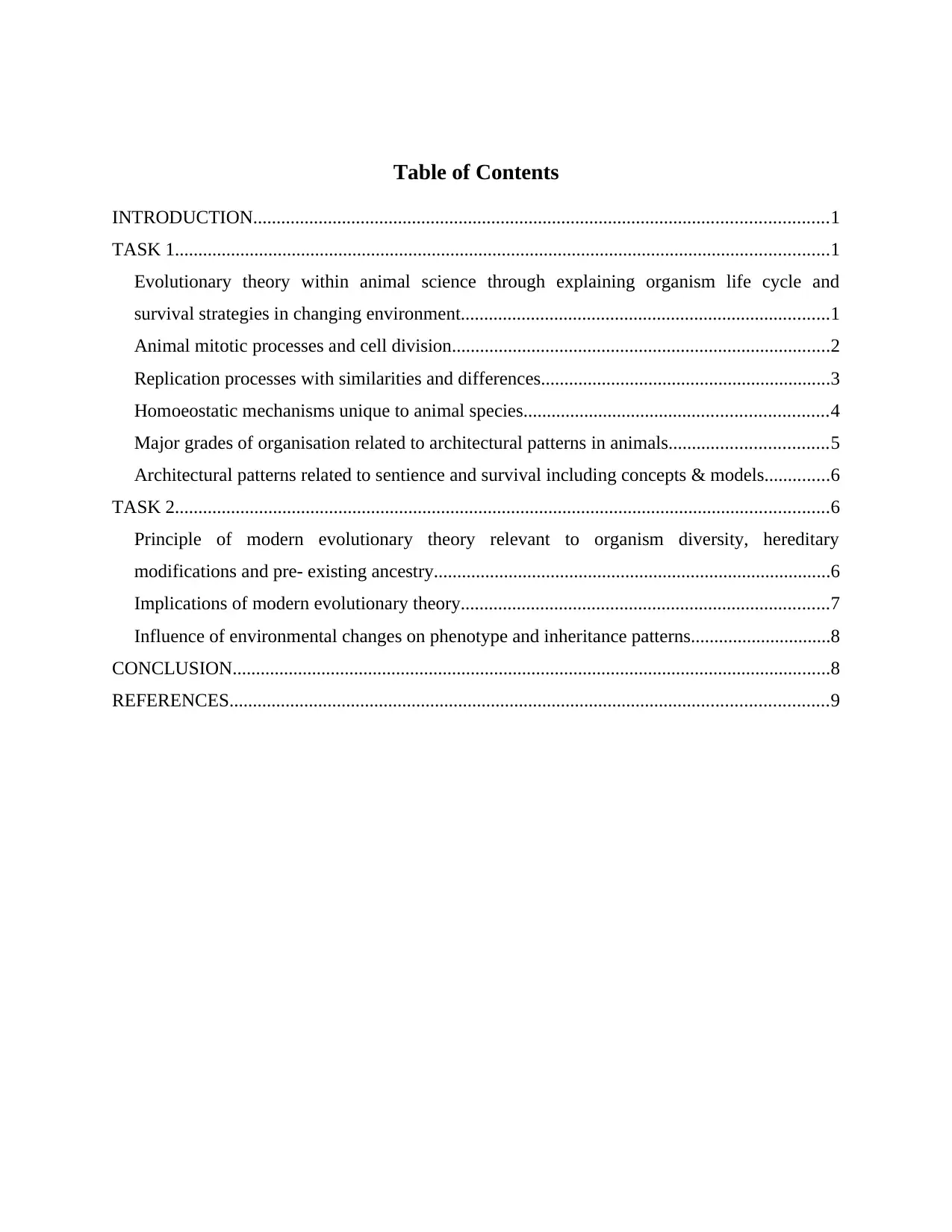
Table of Contents
INTRODUCTION...........................................................................................................................1
TASK 1............................................................................................................................................1
Evolutionary theory within animal science through explaining organism life cycle and
survival strategies in changing environment...............................................................................1
Animal mitotic processes and cell division.................................................................................2
Replication processes with similarities and differences..............................................................3
Homoeostatic mechanisms unique to animal species.................................................................4
Major grades of organisation related to architectural patterns in animals..................................5
Architectural patterns related to sentience and survival including concepts & models..............6
TASK 2............................................................................................................................................6
Principle of modern evolutionary theory relevant to organism diversity, hereditary
modifications and pre- existing ancestry.....................................................................................6
Implications of modern evolutionary theory...............................................................................7
Influence of environmental changes on phenotype and inheritance patterns..............................8
CONCLUSION................................................................................................................................8
REFERENCES................................................................................................................................9
INTRODUCTION...........................................................................................................................1
TASK 1............................................................................................................................................1
Evolutionary theory within animal science through explaining organism life cycle and
survival strategies in changing environment...............................................................................1
Animal mitotic processes and cell division.................................................................................2
Replication processes with similarities and differences..............................................................3
Homoeostatic mechanisms unique to animal species.................................................................4
Major grades of organisation related to architectural patterns in animals..................................5
Architectural patterns related to sentience and survival including concepts & models..............6
TASK 2............................................................................................................................................6
Principle of modern evolutionary theory relevant to organism diversity, hereditary
modifications and pre- existing ancestry.....................................................................................6
Implications of modern evolutionary theory...............................................................................7
Influence of environmental changes on phenotype and inheritance patterns..............................8
CONCLUSION................................................................................................................................8
REFERENCES................................................................................................................................9
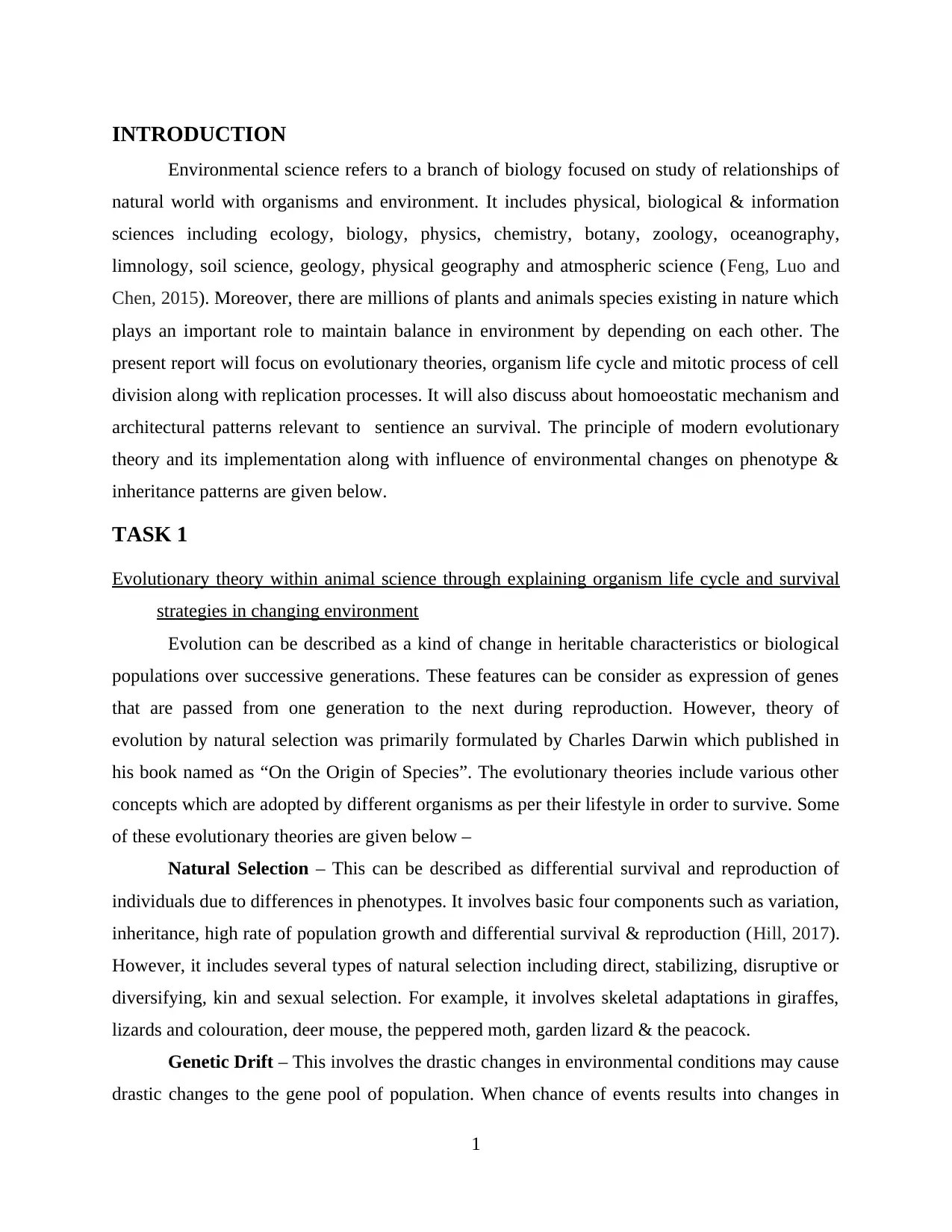
INTRODUCTION
Environmental science refers to a branch of biology focused on study of relationships of
natural world with organisms and environment. It includes physical, biological & information
sciences including ecology, biology, physics, chemistry, botany, zoology, oceanography,
limnology, soil science, geology, physical geography and atmospheric science (Feng, Luo and
Chen, 2015). Moreover, there are millions of plants and animals species existing in nature which
plays an important role to maintain balance in environment by depending on each other. The
present report will focus on evolutionary theories, organism life cycle and mitotic process of cell
division along with replication processes. It will also discuss about homoeostatic mechanism and
architectural patterns relevant to sentience an survival. The principle of modern evolutionary
theory and its implementation along with influence of environmental changes on phenotype &
inheritance patterns are given below.
TASK 1
Evolutionary theory within animal science through explaining organism life cycle and survival
strategies in changing environment
Evolution can be described as a kind of change in heritable characteristics or biological
populations over successive generations. These features can be consider as expression of genes
that are passed from one generation to the next during reproduction. However, theory of
evolution by natural selection was primarily formulated by Charles Darwin which published in
his book named as “On the Origin of Species”. The evolutionary theories include various other
concepts which are adopted by different organisms as per their lifestyle in order to survive. Some
of these evolutionary theories are given below –
Natural Selection – This can be described as differential survival and reproduction of
individuals due to differences in phenotypes. It involves basic four components such as variation,
inheritance, high rate of population growth and differential survival & reproduction (Hill, 2017).
However, it includes several types of natural selection including direct, stabilizing, disruptive or
diversifying, kin and sexual selection. For example, it involves skeletal adaptations in giraffes,
lizards and colouration, deer mouse, the peppered moth, garden lizard & the peacock.
Genetic Drift – This involves the drastic changes in environmental conditions may cause
drastic changes to the gene pool of population. When chance of events results into changes in
1
Environmental science refers to a branch of biology focused on study of relationships of
natural world with organisms and environment. It includes physical, biological & information
sciences including ecology, biology, physics, chemistry, botany, zoology, oceanography,
limnology, soil science, geology, physical geography and atmospheric science (Feng, Luo and
Chen, 2015). Moreover, there are millions of plants and animals species existing in nature which
plays an important role to maintain balance in environment by depending on each other. The
present report will focus on evolutionary theories, organism life cycle and mitotic process of cell
division along with replication processes. It will also discuss about homoeostatic mechanism and
architectural patterns relevant to sentience an survival. The principle of modern evolutionary
theory and its implementation along with influence of environmental changes on phenotype &
inheritance patterns are given below.
TASK 1
Evolutionary theory within animal science through explaining organism life cycle and survival
strategies in changing environment
Evolution can be described as a kind of change in heritable characteristics or biological
populations over successive generations. These features can be consider as expression of genes
that are passed from one generation to the next during reproduction. However, theory of
evolution by natural selection was primarily formulated by Charles Darwin which published in
his book named as “On the Origin of Species”. The evolutionary theories include various other
concepts which are adopted by different organisms as per their lifestyle in order to survive. Some
of these evolutionary theories are given below –
Natural Selection – This can be described as differential survival and reproduction of
individuals due to differences in phenotypes. It involves basic four components such as variation,
inheritance, high rate of population growth and differential survival & reproduction (Hill, 2017).
However, it includes several types of natural selection including direct, stabilizing, disruptive or
diversifying, kin and sexual selection. For example, it involves skeletal adaptations in giraffes,
lizards and colouration, deer mouse, the peppered moth, garden lizard & the peacock.
Genetic Drift – This involves the drastic changes in environmental conditions may cause
drastic changes to the gene pool of population. When chance of events results into changes in
1
⊘ This is a preview!⊘
Do you want full access?
Subscribe today to unlock all pages.

Trusted by 1+ million students worldwide
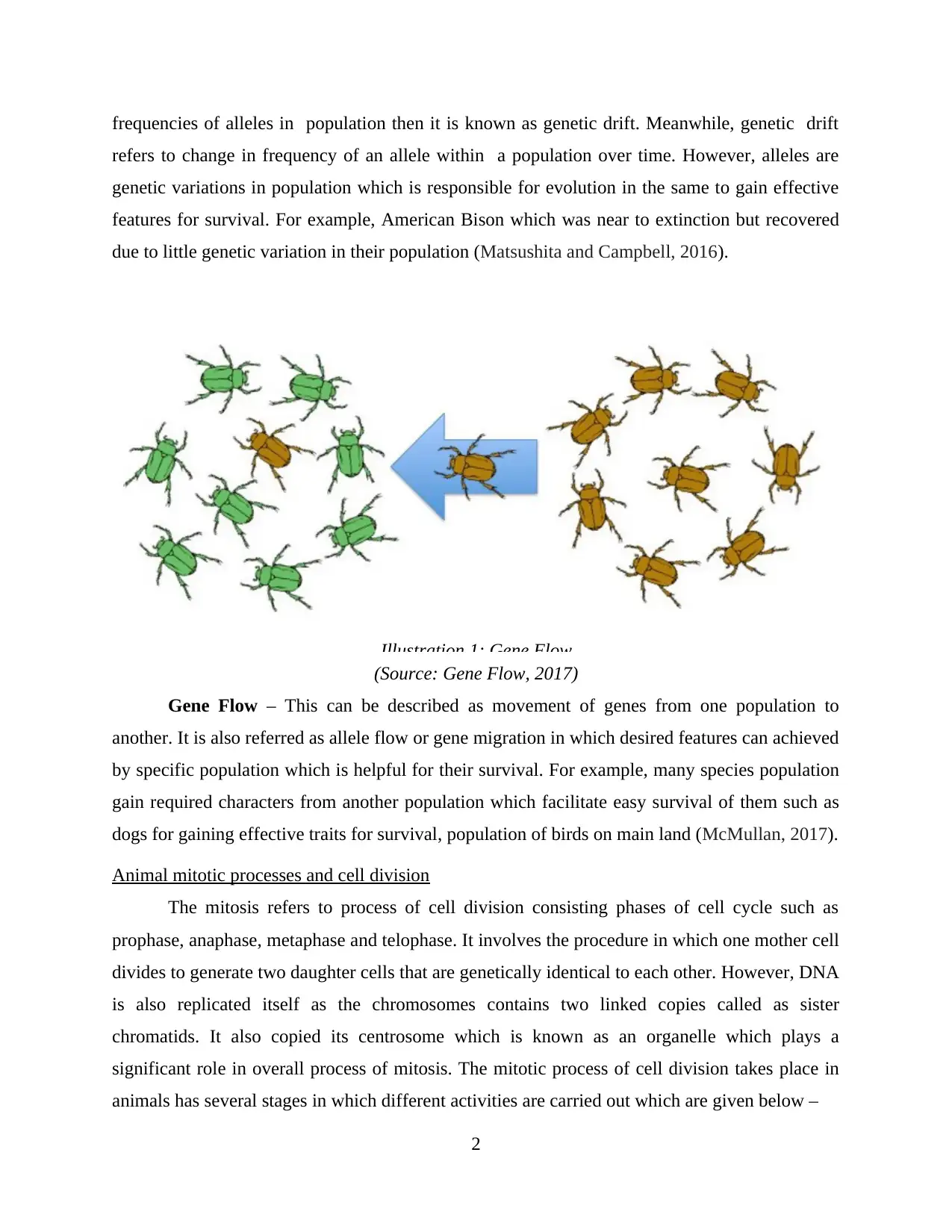
frequencies of alleles in population then it is known as genetic drift. Meanwhile, genetic drift
refers to change in frequency of an allele within a population over time. However, alleles are
genetic variations in population which is responsible for evolution in the same to gain effective
features for survival. For example, American Bison which was near to extinction but recovered
due to little genetic variation in their population (Matsushita and Campbell, 2016).
(Source: Gene Flow, 2017)
Gene Flow – This can be described as movement of genes from one population to
another. It is also referred as allele flow or gene migration in which desired features can achieved
by specific population which is helpful for their survival. For example, many species population
gain required characters from another population which facilitate easy survival of them such as
dogs for gaining effective traits for survival, population of birds on main land (McMullan, 2017).
Animal mitotic processes and cell division
The mitosis refers to process of cell division consisting phases of cell cycle such as
prophase, anaphase, metaphase and telophase. It involves the procedure in which one mother cell
divides to generate two daughter cells that are genetically identical to each other. However, DNA
is also replicated itself as the chromosomes contains two linked copies called as sister
chromatids. It also copied its centrosome which is known as an organelle which plays a
significant role in overall process of mitosis. The mitotic process of cell division takes place in
animals has several stages in which different activities are carried out which are given below –
2
Illustration 1: Gene Flow
refers to change in frequency of an allele within a population over time. However, alleles are
genetic variations in population which is responsible for evolution in the same to gain effective
features for survival. For example, American Bison which was near to extinction but recovered
due to little genetic variation in their population (Matsushita and Campbell, 2016).
(Source: Gene Flow, 2017)
Gene Flow – This can be described as movement of genes from one population to
another. It is also referred as allele flow or gene migration in which desired features can achieved
by specific population which is helpful for their survival. For example, many species population
gain required characters from another population which facilitate easy survival of them such as
dogs for gaining effective traits for survival, population of birds on main land (McMullan, 2017).
Animal mitotic processes and cell division
The mitosis refers to process of cell division consisting phases of cell cycle such as
prophase, anaphase, metaphase and telophase. It involves the procedure in which one mother cell
divides to generate two daughter cells that are genetically identical to each other. However, DNA
is also replicated itself as the chromosomes contains two linked copies called as sister
chromatids. It also copied its centrosome which is known as an organelle which plays a
significant role in overall process of mitosis. The mitotic process of cell division takes place in
animals has several stages in which different activities are carried out which are given below –
2
Illustration 1: Gene Flow
Paraphrase This Document
Need a fresh take? Get an instant paraphrase of this document with our AI Paraphraser
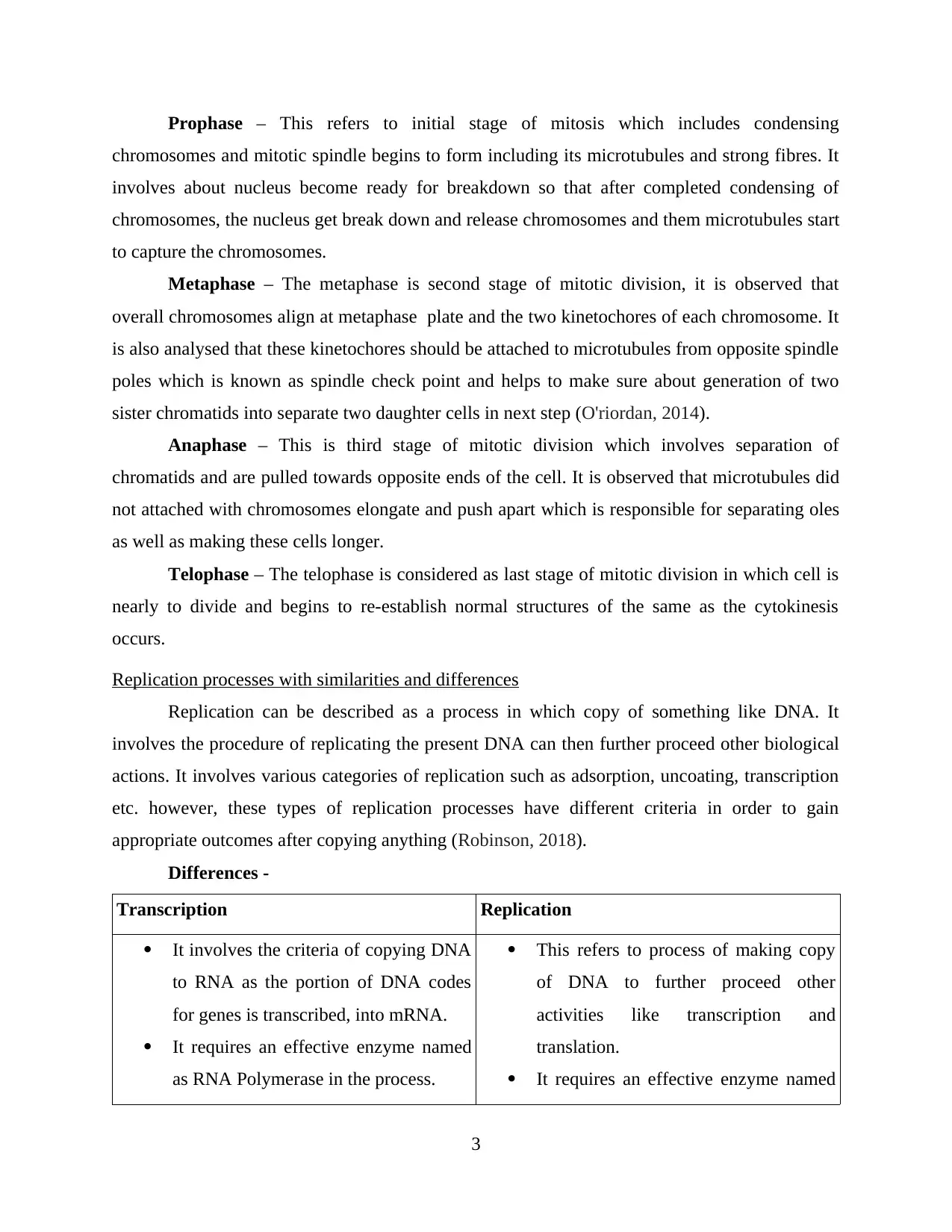
Prophase – This refers to initial stage of mitosis which includes condensing
chromosomes and mitotic spindle begins to form including its microtubules and strong fibres. It
involves about nucleus become ready for breakdown so that after completed condensing of
chromosomes, the nucleus get break down and release chromosomes and them microtubules start
to capture the chromosomes.
Metaphase – The metaphase is second stage of mitotic division, it is observed that
overall chromosomes align at metaphase plate and the two kinetochores of each chromosome. It
is also analysed that these kinetochores should be attached to microtubules from opposite spindle
poles which is known as spindle check point and helps to make sure about generation of two
sister chromatids into separate two daughter cells in next step (O'riordan, 2014).
Anaphase – This is third stage of mitotic division which involves separation of
chromatids and are pulled towards opposite ends of the cell. It is observed that microtubules did
not attached with chromosomes elongate and push apart which is responsible for separating oles
as well as making these cells longer.
Telophase – The telophase is considered as last stage of mitotic division in which cell is
nearly to divide and begins to re-establish normal structures of the same as the cytokinesis
occurs.
Replication processes with similarities and differences
Replication can be described as a process in which copy of something like DNA. It
involves the procedure of replicating the present DNA can then further proceed other biological
actions. It involves various categories of replication such as adsorption, uncoating, transcription
etc. however, these types of replication processes have different criteria in order to gain
appropriate outcomes after copying anything (Robinson, 2018).
Differences -
Transcription Replication
It involves the criteria of copying DNA
to RNA as the portion of DNA codes
for genes is transcribed, into mRNA.
It requires an effective enzyme named
as RNA Polymerase in the process.
This refers to process of making copy
of DNA to further proceed other
activities like transcription and
translation.
It requires an effective enzyme named
3
chromosomes and mitotic spindle begins to form including its microtubules and strong fibres. It
involves about nucleus become ready for breakdown so that after completed condensing of
chromosomes, the nucleus get break down and release chromosomes and them microtubules start
to capture the chromosomes.
Metaphase – The metaphase is second stage of mitotic division, it is observed that
overall chromosomes align at metaphase plate and the two kinetochores of each chromosome. It
is also analysed that these kinetochores should be attached to microtubules from opposite spindle
poles which is known as spindle check point and helps to make sure about generation of two
sister chromatids into separate two daughter cells in next step (O'riordan, 2014).
Anaphase – This is third stage of mitotic division which involves separation of
chromatids and are pulled towards opposite ends of the cell. It is observed that microtubules did
not attached with chromosomes elongate and push apart which is responsible for separating oles
as well as making these cells longer.
Telophase – The telophase is considered as last stage of mitotic division in which cell is
nearly to divide and begins to re-establish normal structures of the same as the cytokinesis
occurs.
Replication processes with similarities and differences
Replication can be described as a process in which copy of something like DNA. It
involves the procedure of replicating the present DNA can then further proceed other biological
actions. It involves various categories of replication such as adsorption, uncoating, transcription
etc. however, these types of replication processes have different criteria in order to gain
appropriate outcomes after copying anything (Robinson, 2018).
Differences -
Transcription Replication
It involves the criteria of copying DNA
to RNA as the portion of DNA codes
for genes is transcribed, into mRNA.
It requires an effective enzyme named
as RNA Polymerase in the process.
This refers to process of making copy
of DNA to further proceed other
activities like transcription and
translation.
It requires an effective enzyme named
3
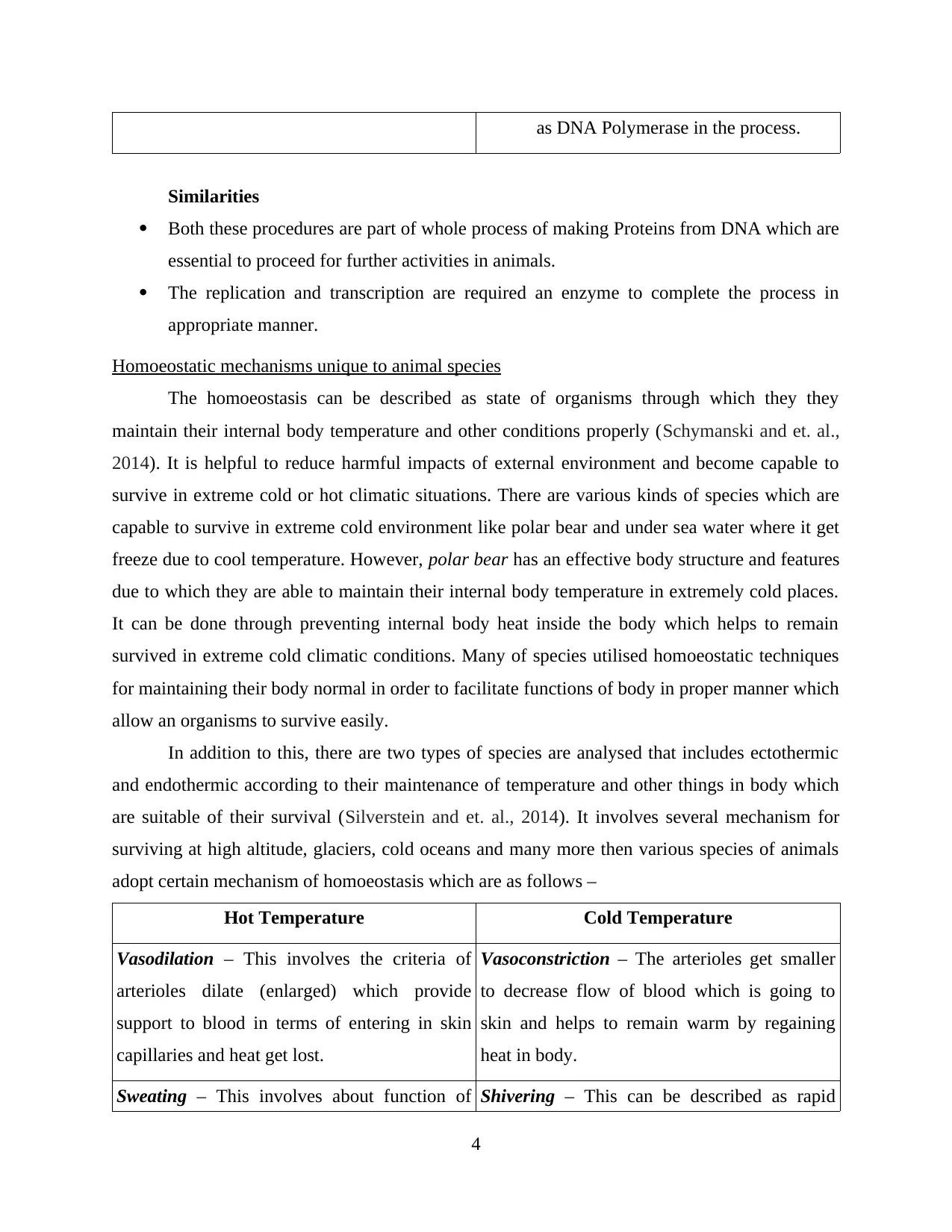
as DNA Polymerase in the process.
Similarities
Both these procedures are part of whole process of making Proteins from DNA which are
essential to proceed for further activities in animals.
The replication and transcription are required an enzyme to complete the process in
appropriate manner.
Homoeostatic mechanisms unique to animal species
The homoeostasis can be described as state of organisms through which they they
maintain their internal body temperature and other conditions properly (Schymanski and et. al.,
2014). It is helpful to reduce harmful impacts of external environment and become capable to
survive in extreme cold or hot climatic situations. There are various kinds of species which are
capable to survive in extreme cold environment like polar bear and under sea water where it get
freeze due to cool temperature. However, polar bear has an effective body structure and features
due to which they are able to maintain their internal body temperature in extremely cold places.
It can be done through preventing internal body heat inside the body which helps to remain
survived in extreme cold climatic conditions. Many of species utilised homoeostatic techniques
for maintaining their body normal in order to facilitate functions of body in proper manner which
allow an organisms to survive easily.
In addition to this, there are two types of species are analysed that includes ectothermic
and endothermic according to their maintenance of temperature and other things in body which
are suitable of their survival (Silverstein and et. al., 2014). It involves several mechanism for
surviving at high altitude, glaciers, cold oceans and many more then various species of animals
adopt certain mechanism of homoeostasis which are as follows –
Hot Temperature Cold Temperature
Vasodilation – This involves the criteria of
arterioles dilate (enlarged) which provide
support to blood in terms of entering in skin
capillaries and heat get lost.
Vasoconstriction – The arterioles get smaller
to decrease flow of blood which is going to
skin and helps to remain warm by regaining
heat in body.
Sweating – This involves about function of Shivering – This can be described as rapid
4
Similarities
Both these procedures are part of whole process of making Proteins from DNA which are
essential to proceed for further activities in animals.
The replication and transcription are required an enzyme to complete the process in
appropriate manner.
Homoeostatic mechanisms unique to animal species
The homoeostasis can be described as state of organisms through which they they
maintain their internal body temperature and other conditions properly (Schymanski and et. al.,
2014). It is helpful to reduce harmful impacts of external environment and become capable to
survive in extreme cold or hot climatic situations. There are various kinds of species which are
capable to survive in extreme cold environment like polar bear and under sea water where it get
freeze due to cool temperature. However, polar bear has an effective body structure and features
due to which they are able to maintain their internal body temperature in extremely cold places.
It can be done through preventing internal body heat inside the body which helps to remain
survived in extreme cold climatic conditions. Many of species utilised homoeostatic techniques
for maintaining their body normal in order to facilitate functions of body in proper manner which
allow an organisms to survive easily.
In addition to this, there are two types of species are analysed that includes ectothermic
and endothermic according to their maintenance of temperature and other things in body which
are suitable of their survival (Silverstein and et. al., 2014). It involves several mechanism for
surviving at high altitude, glaciers, cold oceans and many more then various species of animals
adopt certain mechanism of homoeostasis which are as follows –
Hot Temperature Cold Temperature
Vasodilation – This involves the criteria of
arterioles dilate (enlarged) which provide
support to blood in terms of entering in skin
capillaries and heat get lost.
Vasoconstriction – The arterioles get smaller
to decrease flow of blood which is going to
skin and helps to remain warm by regaining
heat in body.
Sweating – This involves about function of Shivering – This can be described as rapid
4
⊘ This is a preview!⊘
Do you want full access?
Subscribe today to unlock all pages.

Trusted by 1+ million students worldwide
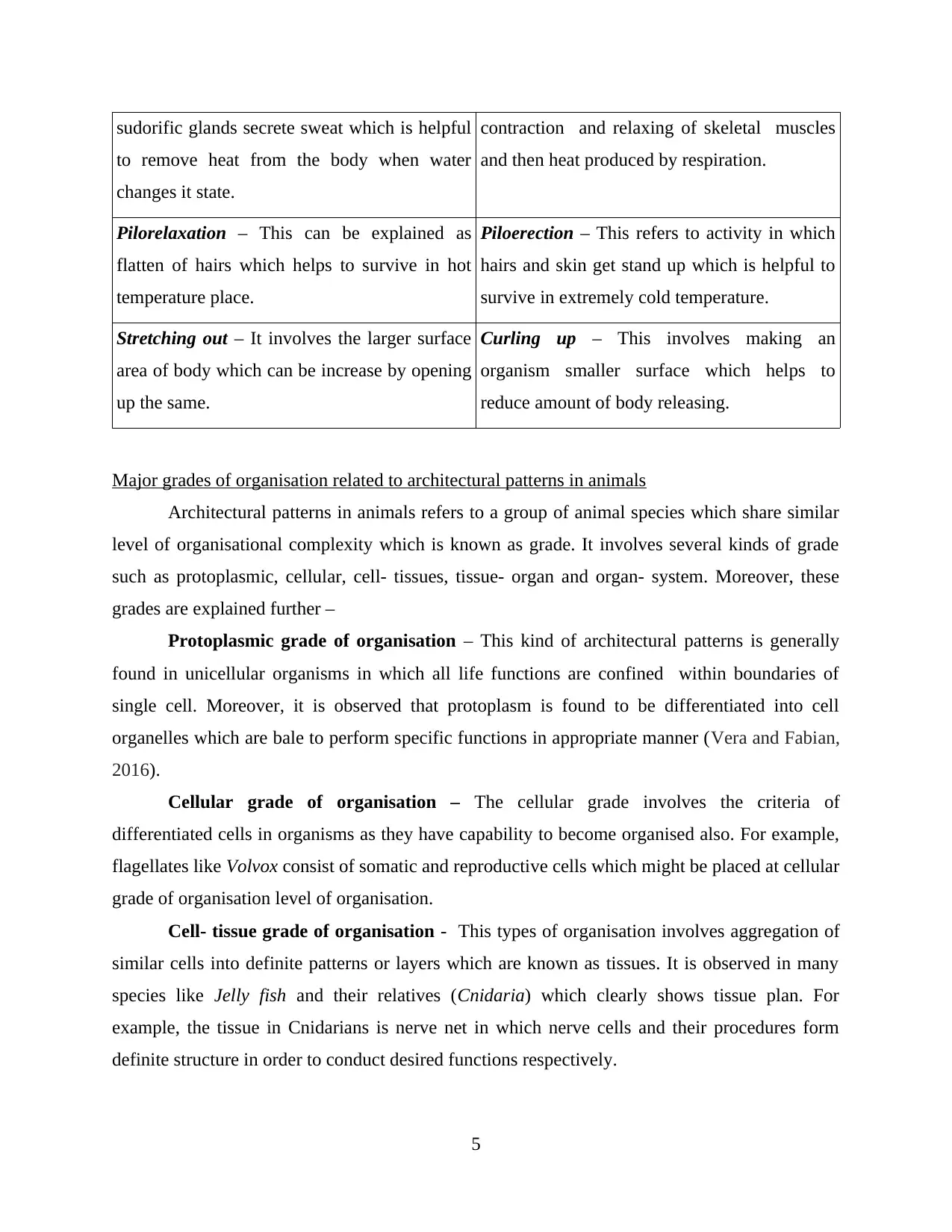
sudorific glands secrete sweat which is helpful
to remove heat from the body when water
changes it state.
contraction and relaxing of skeletal muscles
and then heat produced by respiration.
Pilorelaxation – This can be explained as
flatten of hairs which helps to survive in hot
temperature place.
Piloerection – This refers to activity in which
hairs and skin get stand up which is helpful to
survive in extremely cold temperature.
Stretching out – It involves the larger surface
area of body which can be increase by opening
up the same.
Curling up – This involves making an
organism smaller surface which helps to
reduce amount of body releasing.
Major grades of organisation related to architectural patterns in animals
Architectural patterns in animals refers to a group of animal species which share similar
level of organisational complexity which is known as grade. It involves several kinds of grade
such as protoplasmic, cellular, cell- tissues, tissue- organ and organ- system. Moreover, these
grades are explained further –
Protoplasmic grade of organisation – This kind of architectural patterns is generally
found in unicellular organisms in which all life functions are confined within boundaries of
single cell. Moreover, it is observed that protoplasm is found to be differentiated into cell
organelles which are bale to perform specific functions in appropriate manner (Vera and Fabian,
2016).
Cellular grade of organisation – The cellular grade involves the criteria of
differentiated cells in organisms as they have capability to become organised also. For example,
flagellates like Volvox consist of somatic and reproductive cells which might be placed at cellular
grade of organisation level of organisation.
Cell- tissue grade of organisation - This types of organisation involves aggregation of
similar cells into definite patterns or layers which are known as tissues. It is observed in many
species like Jelly fish and their relatives (Cnidaria) which clearly shows tissue plan. For
example, the tissue in Cnidarians is nerve net in which nerve cells and their procedures form
definite structure in order to conduct desired functions respectively.
5
to remove heat from the body when water
changes it state.
contraction and relaxing of skeletal muscles
and then heat produced by respiration.
Pilorelaxation – This can be explained as
flatten of hairs which helps to survive in hot
temperature place.
Piloerection – This refers to activity in which
hairs and skin get stand up which is helpful to
survive in extremely cold temperature.
Stretching out – It involves the larger surface
area of body which can be increase by opening
up the same.
Curling up – This involves making an
organism smaller surface which helps to
reduce amount of body releasing.
Major grades of organisation related to architectural patterns in animals
Architectural patterns in animals refers to a group of animal species which share similar
level of organisational complexity which is known as grade. It involves several kinds of grade
such as protoplasmic, cellular, cell- tissues, tissue- organ and organ- system. Moreover, these
grades are explained further –
Protoplasmic grade of organisation – This kind of architectural patterns is generally
found in unicellular organisms in which all life functions are confined within boundaries of
single cell. Moreover, it is observed that protoplasm is found to be differentiated into cell
organelles which are bale to perform specific functions in appropriate manner (Vera and Fabian,
2016).
Cellular grade of organisation – The cellular grade involves the criteria of
differentiated cells in organisms as they have capability to become organised also. For example,
flagellates like Volvox consist of somatic and reproductive cells which might be placed at cellular
grade of organisation level of organisation.
Cell- tissue grade of organisation - This types of organisation involves aggregation of
similar cells into definite patterns or layers which are known as tissues. It is observed in many
species like Jelly fish and their relatives (Cnidaria) which clearly shows tissue plan. For
example, the tissue in Cnidarians is nerve net in which nerve cells and their procedures form
definite structure in order to conduct desired functions respectively.
5
Paraphrase This Document
Need a fresh take? Get an instant paraphrase of this document with our AI Paraphraser
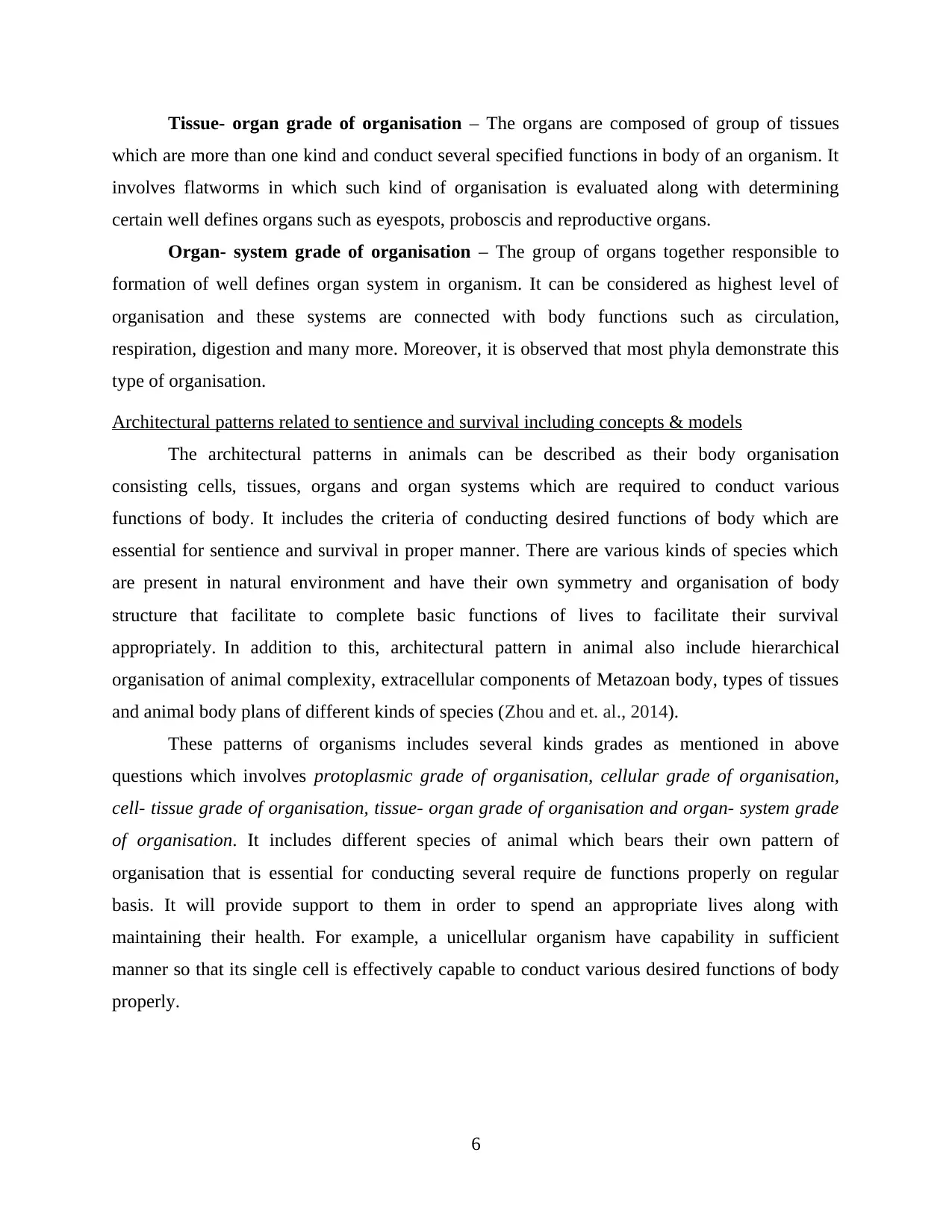
Tissue- organ grade of organisation – The organs are composed of group of tissues
which are more than one kind and conduct several specified functions in body of an organism. It
involves flatworms in which such kind of organisation is evaluated along with determining
certain well defines organs such as eyespots, proboscis and reproductive organs.
Organ- system grade of organisation – The group of organs together responsible to
formation of well defines organ system in organism. It can be considered as highest level of
organisation and these systems are connected with body functions such as circulation,
respiration, digestion and many more. Moreover, it is observed that most phyla demonstrate this
type of organisation.
Architectural patterns related to sentience and survival including concepts & models
The architectural patterns in animals can be described as their body organisation
consisting cells, tissues, organs and organ systems which are required to conduct various
functions of body. It includes the criteria of conducting desired functions of body which are
essential for sentience and survival in proper manner. There are various kinds of species which
are present in natural environment and have their own symmetry and organisation of body
structure that facilitate to complete basic functions of lives to facilitate their survival
appropriately. In addition to this, architectural pattern in animal also include hierarchical
organisation of animal complexity, extracellular components of Metazoan body, types of tissues
and animal body plans of different kinds of species (Zhou and et. al., 2014).
These patterns of organisms includes several kinds grades as mentioned in above
questions which involves protoplasmic grade of organisation, cellular grade of organisation,
cell- tissue grade of organisation, tissue- organ grade of organisation and organ- system grade
of organisation. It includes different species of animal which bears their own pattern of
organisation that is essential for conducting several require de functions properly on regular
basis. It will provide support to them in order to spend an appropriate lives along with
maintaining their health. For example, a unicellular organism have capability in sufficient
manner so that its single cell is effectively capable to conduct various desired functions of body
properly.
6
which are more than one kind and conduct several specified functions in body of an organism. It
involves flatworms in which such kind of organisation is evaluated along with determining
certain well defines organs such as eyespots, proboscis and reproductive organs.
Organ- system grade of organisation – The group of organs together responsible to
formation of well defines organ system in organism. It can be considered as highest level of
organisation and these systems are connected with body functions such as circulation,
respiration, digestion and many more. Moreover, it is observed that most phyla demonstrate this
type of organisation.
Architectural patterns related to sentience and survival including concepts & models
The architectural patterns in animals can be described as their body organisation
consisting cells, tissues, organs and organ systems which are required to conduct various
functions of body. It includes the criteria of conducting desired functions of body which are
essential for sentience and survival in proper manner. There are various kinds of species which
are present in natural environment and have their own symmetry and organisation of body
structure that facilitate to complete basic functions of lives to facilitate their survival
appropriately. In addition to this, architectural pattern in animal also include hierarchical
organisation of animal complexity, extracellular components of Metazoan body, types of tissues
and animal body plans of different kinds of species (Zhou and et. al., 2014).
These patterns of organisms includes several kinds grades as mentioned in above
questions which involves protoplasmic grade of organisation, cellular grade of organisation,
cell- tissue grade of organisation, tissue- organ grade of organisation and organ- system grade
of organisation. It includes different species of animal which bears their own pattern of
organisation that is essential for conducting several require de functions properly on regular
basis. It will provide support to them in order to spend an appropriate lives along with
maintaining their health. For example, a unicellular organism have capability in sufficient
manner so that its single cell is effectively capable to conduct various desired functions of body
properly.
6
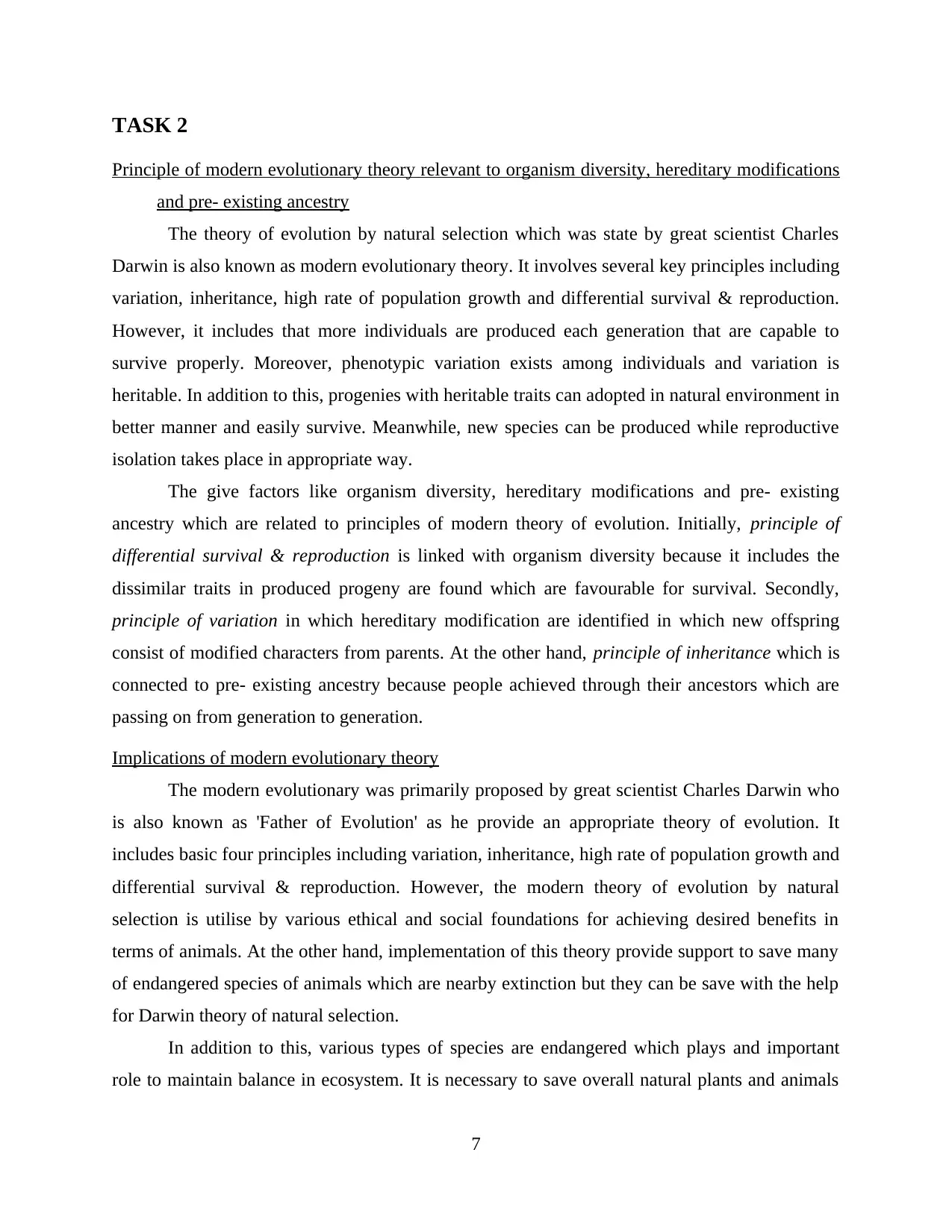
TASK 2
Principle of modern evolutionary theory relevant to organism diversity, hereditary modifications
and pre- existing ancestry
The theory of evolution by natural selection which was state by great scientist Charles
Darwin is also known as modern evolutionary theory. It involves several key principles including
variation, inheritance, high rate of population growth and differential survival & reproduction.
However, it includes that more individuals are produced each generation that are capable to
survive properly. Moreover, phenotypic variation exists among individuals and variation is
heritable. In addition to this, progenies with heritable traits can adopted in natural environment in
better manner and easily survive. Meanwhile, new species can be produced while reproductive
isolation takes place in appropriate way.
The give factors like organism diversity, hereditary modifications and pre- existing
ancestry which are related to principles of modern theory of evolution. Initially, principle of
differential survival & reproduction is linked with organism diversity because it includes the
dissimilar traits in produced progeny are found which are favourable for survival. Secondly,
principle of variation in which hereditary modification are identified in which new offspring
consist of modified characters from parents. At the other hand, principle of inheritance which is
connected to pre- existing ancestry because people achieved through their ancestors which are
passing on from generation to generation.
Implications of modern evolutionary theory
The modern evolutionary was primarily proposed by great scientist Charles Darwin who
is also known as 'Father of Evolution' as he provide an appropriate theory of evolution. It
includes basic four principles including variation, inheritance, high rate of population growth and
differential survival & reproduction. However, the modern theory of evolution by natural
selection is utilise by various ethical and social foundations for achieving desired benefits in
terms of animals. At the other hand, implementation of this theory provide support to save many
of endangered species of animals which are nearby extinction but they can be save with the help
for Darwin theory of natural selection.
In addition to this, various types of species are endangered which plays and important
role to maintain balance in ecosystem. It is necessary to save overall natural plants and animals
7
Principle of modern evolutionary theory relevant to organism diversity, hereditary modifications
and pre- existing ancestry
The theory of evolution by natural selection which was state by great scientist Charles
Darwin is also known as modern evolutionary theory. It involves several key principles including
variation, inheritance, high rate of population growth and differential survival & reproduction.
However, it includes that more individuals are produced each generation that are capable to
survive properly. Moreover, phenotypic variation exists among individuals and variation is
heritable. In addition to this, progenies with heritable traits can adopted in natural environment in
better manner and easily survive. Meanwhile, new species can be produced while reproductive
isolation takes place in appropriate way.
The give factors like organism diversity, hereditary modifications and pre- existing
ancestry which are related to principles of modern theory of evolution. Initially, principle of
differential survival & reproduction is linked with organism diversity because it includes the
dissimilar traits in produced progeny are found which are favourable for survival. Secondly,
principle of variation in which hereditary modification are identified in which new offspring
consist of modified characters from parents. At the other hand, principle of inheritance which is
connected to pre- existing ancestry because people achieved through their ancestors which are
passing on from generation to generation.
Implications of modern evolutionary theory
The modern evolutionary was primarily proposed by great scientist Charles Darwin who
is also known as 'Father of Evolution' as he provide an appropriate theory of evolution. It
includes basic four principles including variation, inheritance, high rate of population growth and
differential survival & reproduction. However, the modern theory of evolution by natural
selection is utilise by various ethical and social foundations for achieving desired benefits in
terms of animals. At the other hand, implementation of this theory provide support to save many
of endangered species of animals which are nearby extinction but they can be save with the help
for Darwin theory of natural selection.
In addition to this, various types of species are endangered which plays and important
role to maintain balance in ecosystem. It is necessary to save overall natural plants and animals
7
⊘ This is a preview!⊘
Do you want full access?
Subscribe today to unlock all pages.

Trusted by 1+ million students worldwide
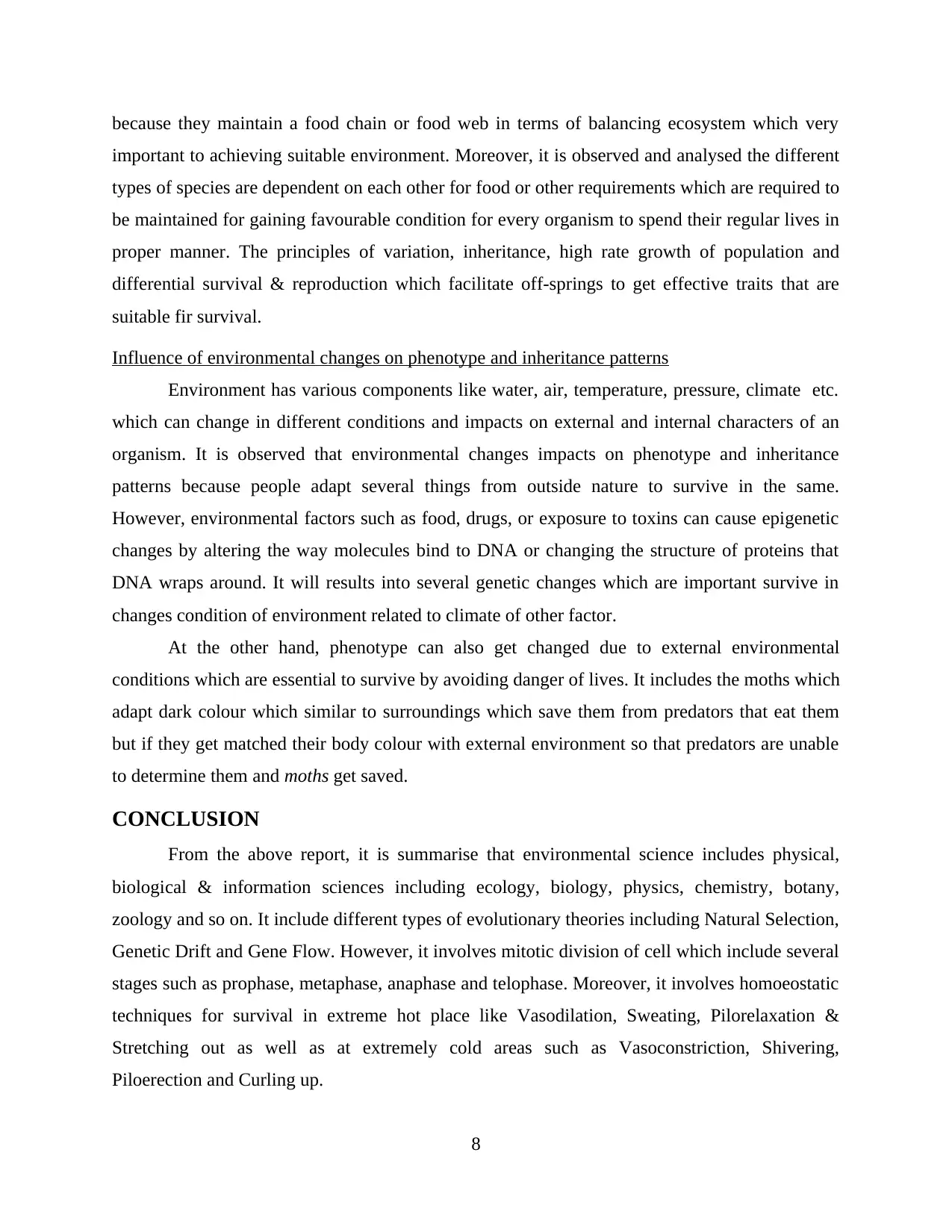
because they maintain a food chain or food web in terms of balancing ecosystem which very
important to achieving suitable environment. Moreover, it is observed and analysed the different
types of species are dependent on each other for food or other requirements which are required to
be maintained for gaining favourable condition for every organism to spend their regular lives in
proper manner. The principles of variation, inheritance, high rate growth of population and
differential survival & reproduction which facilitate off-springs to get effective traits that are
suitable fir survival.
Influence of environmental changes on phenotype and inheritance patterns
Environment has various components like water, air, temperature, pressure, climate etc.
which can change in different conditions and impacts on external and internal characters of an
organism. It is observed that environmental changes impacts on phenotype and inheritance
patterns because people adapt several things from outside nature to survive in the same.
However, environmental factors such as food, drugs, or exposure to toxins can cause epigenetic
changes by altering the way molecules bind to DNA or changing the structure of proteins that
DNA wraps around. It will results into several genetic changes which are important survive in
changes condition of environment related to climate of other factor.
At the other hand, phenotype can also get changed due to external environmental
conditions which are essential to survive by avoiding danger of lives. It includes the moths which
adapt dark colour which similar to surroundings which save them from predators that eat them
but if they get matched their body colour with external environment so that predators are unable
to determine them and moths get saved.
CONCLUSION
From the above report, it is summarise that environmental science includes physical,
biological & information sciences including ecology, biology, physics, chemistry, botany,
zoology and so on. It include different types of evolutionary theories including Natural Selection,
Genetic Drift and Gene Flow. However, it involves mitotic division of cell which include several
stages such as prophase, metaphase, anaphase and telophase. Moreover, it involves homoeostatic
techniques for survival in extreme hot place like Vasodilation, Sweating, Pilorelaxation &
Stretching out as well as at extremely cold areas such as Vasoconstriction, Shivering,
Piloerection and Curling up.
8
important to achieving suitable environment. Moreover, it is observed and analysed the different
types of species are dependent on each other for food or other requirements which are required to
be maintained for gaining favourable condition for every organism to spend their regular lives in
proper manner. The principles of variation, inheritance, high rate growth of population and
differential survival & reproduction which facilitate off-springs to get effective traits that are
suitable fir survival.
Influence of environmental changes on phenotype and inheritance patterns
Environment has various components like water, air, temperature, pressure, climate etc.
which can change in different conditions and impacts on external and internal characters of an
organism. It is observed that environmental changes impacts on phenotype and inheritance
patterns because people adapt several things from outside nature to survive in the same.
However, environmental factors such as food, drugs, or exposure to toxins can cause epigenetic
changes by altering the way molecules bind to DNA or changing the structure of proteins that
DNA wraps around. It will results into several genetic changes which are important survive in
changes condition of environment related to climate of other factor.
At the other hand, phenotype can also get changed due to external environmental
conditions which are essential to survive by avoiding danger of lives. It includes the moths which
adapt dark colour which similar to surroundings which save them from predators that eat them
but if they get matched their body colour with external environment so that predators are unable
to determine them and moths get saved.
CONCLUSION
From the above report, it is summarise that environmental science includes physical,
biological & information sciences including ecology, biology, physics, chemistry, botany,
zoology and so on. It include different types of evolutionary theories including Natural Selection,
Genetic Drift and Gene Flow. However, it involves mitotic division of cell which include several
stages such as prophase, metaphase, anaphase and telophase. Moreover, it involves homoeostatic
techniques for survival in extreme hot place like Vasodilation, Sweating, Pilorelaxation &
Stretching out as well as at extremely cold areas such as Vasoconstriction, Shivering,
Piloerection and Curling up.
8
Paraphrase This Document
Need a fresh take? Get an instant paraphrase of this document with our AI Paraphraser
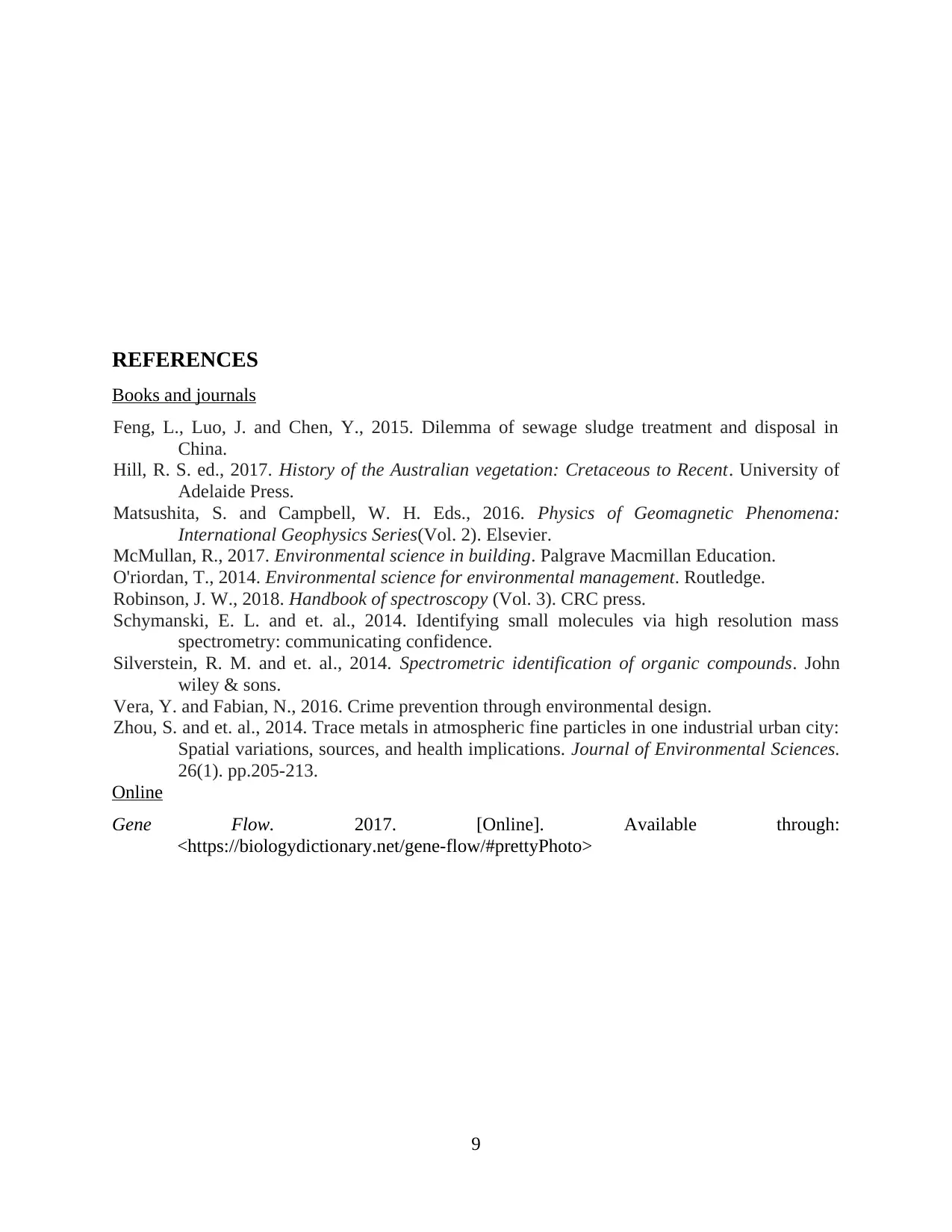
REFERENCES
Books and journals
Feng, L., Luo, J. and Chen, Y., 2015. Dilemma of sewage sludge treatment and disposal in
China.
Hill, R. S. ed., 2017. History of the Australian vegetation: Cretaceous to Recent. University of
Adelaide Press.
Matsushita, S. and Campbell, W. H. Eds., 2016. Physics of Geomagnetic Phenomena:
International Geophysics Series(Vol. 2). Elsevier.
McMullan, R., 2017. Environmental science in building. Palgrave Macmillan Education.
O'riordan, T., 2014. Environmental science for environmental management. Routledge.
Robinson, J. W., 2018. Handbook of spectroscopy (Vol. 3). CRC press.
Schymanski, E. L. and et. al., 2014. Identifying small molecules via high resolution mass
spectrometry: communicating confidence.
Silverstein, R. M. and et. al., 2014. Spectrometric identification of organic compounds. John
wiley & sons.
Vera, Y. and Fabian, N., 2016. Crime prevention through environmental design.
Zhou, S. and et. al., 2014. Trace metals in atmospheric fine particles in one industrial urban city:
Spatial variations, sources, and health implications. Journal of Environmental Sciences.
26(1). pp.205-213.
Online
Gene Flow. 2017. [Online]. Available through:
<https://biologydictionary.net/gene-flow/#prettyPhoto>
9
Books and journals
Feng, L., Luo, J. and Chen, Y., 2015. Dilemma of sewage sludge treatment and disposal in
China.
Hill, R. S. ed., 2017. History of the Australian vegetation: Cretaceous to Recent. University of
Adelaide Press.
Matsushita, S. and Campbell, W. H. Eds., 2016. Physics of Geomagnetic Phenomena:
International Geophysics Series(Vol. 2). Elsevier.
McMullan, R., 2017. Environmental science in building. Palgrave Macmillan Education.
O'riordan, T., 2014. Environmental science for environmental management. Routledge.
Robinson, J. W., 2018. Handbook of spectroscopy (Vol. 3). CRC press.
Schymanski, E. L. and et. al., 2014. Identifying small molecules via high resolution mass
spectrometry: communicating confidence.
Silverstein, R. M. and et. al., 2014. Spectrometric identification of organic compounds. John
wiley & sons.
Vera, Y. and Fabian, N., 2016. Crime prevention through environmental design.
Zhou, S. and et. al., 2014. Trace metals in atmospheric fine particles in one industrial urban city:
Spatial variations, sources, and health implications. Journal of Environmental Sciences.
26(1). pp.205-213.
Online
Gene Flow. 2017. [Online]. Available through:
<https://biologydictionary.net/gene-flow/#prettyPhoto>
9
1 out of 11
Related Documents
Your All-in-One AI-Powered Toolkit for Academic Success.
+13062052269
info@desklib.com
Available 24*7 on WhatsApp / Email
![[object Object]](/_next/static/media/star-bottom.7253800d.svg)
Unlock your academic potential
Copyright © 2020–2025 A2Z Services. All Rights Reserved. Developed and managed by ZUCOL.





